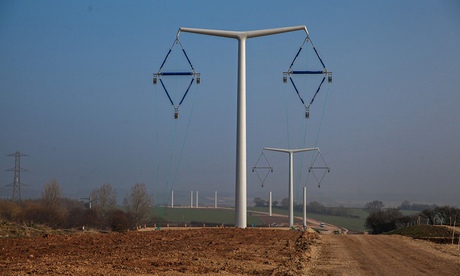
A new style of electricity pylon has been unveiled by the National Grid. But was there anything wrong with the old design, which has traversed the country for almost 90 years?
The traditional lattice tower came about as the result of a 1928 competition, judged by the architect Sir Reginald Blomfeld, who selected a design by the Milliken Brothers. Over the years, the structure has developed as new materials became available and demand to carry higher voltages grew, requiring longer insulator strings. Yet the basic shape – a narrow A-frame – has stayed the same.
Beloved of engineers, the traditional pylon is adaptable and, like Meccano, can be adjusted as the landscape requires, with options for lower height near airfields or huge towers to cross rivers. With a see-through lattice design, they stand out far less than a solid pole.
As pylons began to cross the country, people were inspired by them. Stephen Spender, one of the “pylon poets”, wrote of them: “But far above and far as sight endures/ Like whips of anger/ With lightning’s danger/ There runs the quick perspective of the future.” This evocative nature was reflected in a postwar public information film, Prelude to Prosperity, which uses footage of pylon construction set to dramatic music to explain how the expansion of the National Grid was a positive thing, illustrating economic growth and new opportunities, stating, “Thus can we hope for a life more worthwhile”.
Nowadays, many people feel pylons are a blot on the landscape, as evidenced by the inevitable objections to any new power lines. Instead, they call for the wires to run underground. But this is expensive, harder to maintain when there are problems – as seen in the fire in London’s Holborn earlier this month – and can cause a scar on the land, as opposed to pylons with their small footprint.
However, perhaps in the face of this public feeling and the need to expand the transmission network, the National Grid decided it was time for a change and launched a competition, along with the Royal Institute of British Architects and the Department of Energy and Climate Change, to create the pylon of the future. The shortlist included stunning blades, evocative sails and totem poles. But in the end, a streetlight-style T-shaped pole was selected.
Designed by Danish architect Bystrup, the T-pylon is shorter than the lattice of old, which is achieved by stringing the wires in a triangular configuration. However, the style feels somewhat safe, as if to appease the detractors – after all, barely anyone objects to lamp-posts. What a wasted opportunity to drop more innovative sculptures across the landscape.
The T-pylon also has its limitations. It cannot be climbed, so it is maintained via cherry pickers. Instead of being painted by hand, as a traditional lattice would be, it will come prefabricated. This reduces the possibility of inventive use of colour, either for camouflage or decoration, and as a solid pole, it will be more visible than a lattice.
Although existing pylons will stay in place until they are redundant or inadequate, the T-pylon will be introduced along new power lines, such as those for the proposed Hinckley C power station in Somerset. As the new pylon design has an intended working life of 80 years, over time the landscape around it will change.
Perhaps future generations will look back at the lattice with fond nostalgia. As the saying goes: you don’t know what you’ve got till it’s gone.

